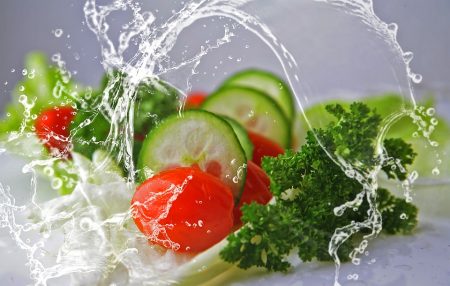 Editor’s Note: This article originally appeared in The Conversation Canada and was picked up by the Daily Mail and National Post.
Editor’s Note: This article originally appeared in The Conversation Canada and was picked up by the Daily Mail and National Post.
While the recent outbreak of E. coli infections linked to romaine lettuce has been declared over, Canadian public health officials are still working to determine the cause of the contamination.
Several people in the U.S. and eastern Canada were sickened after eating romaine, with two reported deaths.
I am a food safety expert. Here’s what consumers need to know about E. coli and produce:
Why produce and why E. coli?
E. coli are bacteria that live naturally in the intestines of cattle, poultry and other animals. For the most part, they co-exist with these animals, and hence they don’t become sick.
Most of the E. coli strains associated with humans are harmless, and, in fact, are an important part of a healthy human intestinal tract. However, some E. coli strains are pathogenic, meaning they can cause human illness. Pathogenic E. coli that can cause diarrhea can be transmitted through contaminated water or food, or through contact with animals or people.
How does produce become contaminated?
There are many different ways that produce can become contaminated. Firstly, in the farmer’s field, produce can become contaminated with pathogenic E. coli through direct contact with animal feces.
For example, wild animals, like feral pigs and deer rummaging through farm fields, have previously been found to be linked to cases of illness due to spinach and strawberries, respectively.
In fact, any time produce in the field makes contact with animal feces, it could lead to the contamination of that produce with a pathogen. Contaminated irrigation water, bird feces or improperly composted manure are other potential sources of pathogenic bacteria.
Once produce is sent from the farmers’ fields to processing plants, there are other potential sources of microbial contamination, including the water used to wash the produce and the equipment used to cut up the leafy greens.
Further along the food chain at the retail store, if the produce is not bagged, there is also the chance for cross-contamination in the store from raw foods — for example, from cutting boards and counters that have been in contact with raw meat and haven’t been properly disinfected between uses.
More produce-related outbreaks now?
It appears that there are now more cases of illness due to produce. There are a few reasons for this.
Firstly, there has been a large increase in the sale of bagged greens and salad kits as consumers are making an effort to try to eat more fruits and vegetables.
Secondly, we’re getting much better at detecting and stopping food-borne outbreaks in their tracks due to a new molecular typing technique referred to as whole genome sequencing (WGS), which is a much more sensitive typing method than ones public health officials have been using. WGS identifies pathogens isolated from food or environmental samples. These can then be compared to clinical samples isolated from patients.
The technology has proven to be extremely valuable in making a link between a food-borne illness and a contaminated food. Previously, outbreaks caused by contaminated produce were either missed or a food product could not be linked to illnesses because of the poor sensitivity of the typing method. Thanks to WGS, those links are now more quickly identified and tied to a specific fruit or vegetable.
Trace an outbreak back to a certain farm
In some cases, it may be straightforward to trace a contaminated produce item back to a certain field or farm. However, in other cases, because of the complex distribution systems, there may be a commingling of products from many different farms going into one central farm distribution centre, which then ships products to Canada.
This can make it extremely difficult to trace a product back to its source.
A lot of progress, however, has been made toward the ambitious goal of being able to quickly trace contaminated produce back to its field of origin. One example of this is the Produce Traceability Initiative, an organization sponsored by North American produce associations that helps the industry track fruits and vegetables.

Why no romaine recall?
In the most recent outbreak, there was epidemiological evidence collected initially that found an association between the human cases and the consumption of romaine lettuce.
However, in spite of all the evidence that was gathered during the outbreak in Canada, no common supplier, distributor or retailer of romaine lettuce was identified as a possible source of the outbreak.
In fact, people reported eating romaine lettuce at home, in restaurants and fast-food chains and from prepared salads bought at grocery stores, further complicating the picture.
In addition, all test samples of romaine lettuce in question were negative.
It therefore becomes difficult for regulatory agencies to do a recall when they can’t pinpoint the actual origin of the product. Further complicating the issue is lettuce’s relatively short shelf life. In most cases, much of the product that caused the illnesses has already been consumed or spoiled, and so isn’t available for tracing information or microbiological analysis.
Furthermore, regulatory agencies don’t want to issue a recall too quickly because of public pressure.
For example, in the late 1990s, a big food-borne outbreak occurred due a protozoan parasite called Cyclospora, and the outbreak was quickly blamed on Californian strawberries.
However, the outbreak was later linked to Guatemalan raspberries. The mistake cost the California strawberry industry millions of dollars.
Did Canadian health officials do the right thing?
On Dec. 11, 2017, officials at the Public Health Agency of Canada said they were investigating the outbreak of E. coli 0157 linked to the consumption of romaine lettuce, which was occurring in three provinces.
On Dec. 14, the notice was updated to include two additional provinces, Ontario and Nova Scotia, which had reported illnesses linked to the outbreak, bringing the total number of cases to 30 cases, including one death.
On Dec. 21, the notice was updated to include 10 additional cases (a total of 40 cases) and advised consumers in Ontario, Quebec, New Brunswick, Nova Scotia and Newfoundland and Labrador that they should consider consuming other types of lettuce instead of romaine until more was known about the outbreak and the cause of contamination.
Furthermore, on Dec. 28, the notice was again updated to include one additional case, and stated that there was an ongoing risk of E. coli infections associated with the consumption of romaine lettuce in Canada’s eastern provinces.
Finally, on Jan. 10 of this year, federal officials put out a notice stating that the outbreak appeared to be over and that the overall risk to Canadians had returned to low. At this point, they were no longer advising individuals in affected provinces to avoid romaine lettuce.
Thus, consumers in Canada’s eastern provinces were told for about 20 days not to eat romaine, and it took about 10 days from the start of the outbreak until they were told this.
Is this a reasonable time period? Should there have been a recall of romaine lettuce in the affected provinces?
I think so.
Some stores pulled romaine lettuce and others kept it on the shelves, confusing the consumer.
This outbreak in particular would benefit from a post-mortem analysis to see what, if anything, could have been done better and what consumers truly understood in light of all the warnings and social media chatter.
 Should consumers wash their pre-washed bags of produce?
Should consumers wash their pre-washed bags of produce?
Consumers do not need to wash their packaged triple-washed bags of leafy greens, and can actually make things worse if they do, as during the course of washing, they can cross-contaminate the product.
If consumers feel better doing the extra wash, they should use safe-handling practices to avoid any cross-contamination. Start with hand-washing for 20 seconds with warm water and soap before and after handling the product.
Then it’s critical that consumers wash their cutting boards before using them (as well as dishes, salad spinners, utensils and countertops) to avoid cross-contamination between, for example, raw meats and ready-to-eat leafy greens. Plastic cutting boards can be placed in the dishwasher to be disinfected.
When you’re washing your cutting board by hand, you should first rinse off any visible debris and then scrub the cutting board with soap and water. Finally, you should be sanitizing the cutting board.
Bagged leafy greens should, of course, also be refrigerated, and consumers should consume the product before its best-before date.
Reducing consumer risk
Firstly, consumers should buy their produce from reputable retail operations.
When shopping, keep your fruits and vegetables separated from raw meat, poultry and fish to prevent cross-contamination
At home, store your fruits and vegetables in the refrigerator in a produce drawer separate from the raw meat, poultry or fish. Follow the aforementioned washing techniques.
![]() Wash your hands with hot, soapy water for at least 20 seconds before and after handling fresh fruits and vegetables. Wash produce well under running water (do not use soap or chemicals), including fruits and vegetables from farmers markets, roadside stands or your home garden.
Wash your hands with hot, soapy water for at least 20 seconds before and after handling fresh fruits and vegetables. Wash produce well under running water (do not use soap or chemicals), including fruits and vegetables from farmers markets, roadside stands or your home garden.